The first Lincoln Memorial pennies were introduced in 1959, when the U.S. Mint redesigned the reverse side of the coin. The value of the 1961 penny depends on factors such as its mintage, mint mark, and the fact that it’s part of the early years of the Memorial cent series.
While many people assume pennies are practically worthless because of their low face value, that’s not always the case. For instance, even a penny selling for $1 is technically valued at 100 times its face value — hardly a “cheap” coin when you look at it that way!
1961 Penny Value Chart
| Condition | 1961 No Mint Mark Penny | 1961-D Penny |
|---|---|---|
| MS60 | $0.17 | $0.17 |
| MS65 | $18 | $15 |
| PR65 | $15 | / |
History of the 1961 Penny

The first Lincoln pennies debuted in 1909, marking the 100th anniversary of Abraham Lincoln’s birth. This release was historic, as it was the first U.S. coin to feature a real person — and a President — on the obverse.
At the time, this was a bold move. Traditionally, U.S. coins had avoided depicting actual individuals, following George Washington’s belief that such a practice felt too monarchical and reminiscent of British customs.
1961 Penny Types and Mintage
| Location | Type | Mintage |
|---|---|---|
| Philadelphia | 1961 (No Mint Mark) | 753,345,000 |
| Philadelphia | 1961 Proof | 3,028,244 |
| Denver | 1961-D | 1,753,266,700 |
| Total | — | 2,509,639,944 |
In 1959, to celebrate the 150th anniversary of Lincoln’s birth, the U.S. Mint decided to retain the original obverse portrait but introduced a new reverse design.
The change replaced the iconic wheat ears with a detailed depiction of the Lincoln Memorial, designed by engraver Frank Gasparro. If you look closely between the columns of the monument, you’ll spot a tiny rendering of the Lincoln statue — just like the one inside the actual memorial in Washington, D.C. This subtle detail added to the uniqueness and artistic merit of the coin, making it one of the most recognizable coins in American history.
Although Lincoln Memorial cents continue to circulate today, earlier designs — especially those like the 1961 issue — are sought after by collectors. While not yet considered “old,” 1961 pennies in high mint state grades can hold significant value.
Features of the 1961 Lincoln Memorial Penny
The obverse of the 1961 Memorial penny
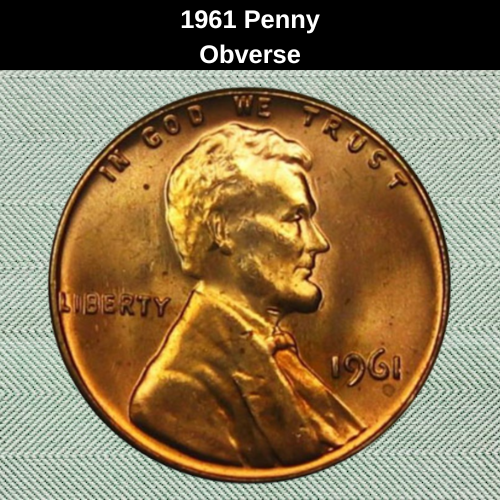
Unlike the reverse, which has undergone several redesigns over the decades, the obverse of the Lincoln cent has remained virtually unchanged since its debut. As a result, the 1961 Lincoln Memorial penny features the same profile of Abraham Lincoln as seen on the original 1909 coins.
In addition to Lincoln’s bust, this side of the coin includes several key inscriptions. The year “1961” appears to the right, and on coins struck in Denver, a “D” mint mark is located just below the date. Above Lincoln’s head is the national motto, “IN GOD WE TRUST”, reflecting both hope and the enduring faith of the American people. The word “LIBERTY” is placed to the left of the portrait.
Finally, beneath Lincoln’s shoulder, you’ll find the small initials “VDB”, representing the coin’s original designer, Victor David Brenner.
The reverse of the 1961 Memorial penny
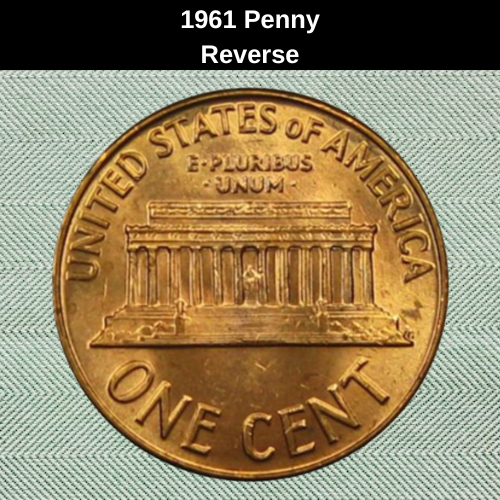
As the name implies, the reverse of the 1961 Lincoln penny features the Lincoln Memorial, occupying most of the coin’s surface. Surrounding this iconic building are several inscriptions.
Beneath the Memorial is the denomination “ONE CENT”, while the top edge reads “UNITED STATES OF AMERICA.” Just below that, you’ll find the Latin motto “E·PLURIBUS·UNUM.”
One of the most intriguing details of Frank Gasparro’s design is a tiny depiction of Abraham Lincoln sitting inside the Memorial, visible between the two central columns. This subtle feature pays tribute to the statue housed in the real monument in Washington, D.C. You can also spot Gasparro’s initials (FG) on the right side of the steps.
When examining these pennies, take a close look at the steps of the Memorial. The original design includes six distinct steps, but most circulated coins lack clear definition. Coins with 5 or 6 clearly visible steps—known as Full Steps varieties—are highly desirable among collectors. In contrast, coins with fewer than four visible steps are less sought-after and generally hold lower value.
1961 Lincoln Penny Specifications:
- Face Value: $0.01 (One Cent)
- Composition: 95% Copper, 5% Tin and Zinc
- Weight: 3.11 grams (0.11 oz)
- Diameter: 19.05 mm (0.75 inches)
- Thickness: 1.52 mm (0.06 inches)
- Shape: Round
- Edge: Plain
Additional Characteristics of the 1961 Lincoln Penny
The 1961 Lincoln Memorial cents share the same physical traits as other coins in the series. They have a plain edge, weigh 3.11 grams (or 0.11 ounces), and measure 19.05 mm (0.75 inches) in diameter. Their thickness is 1.52 mm (0.06 inches). These coins are composed of an alloy containing 95% copper and 5% tin or zinc.
Grading the 1961 Lincoln Penny
Because most 1961 pennies are common and relatively low in value, collectors rarely invest in professional grading unless the coin shows something rare or unique. In such cases, expert evaluation is essential to determine the coin’s position on the Sheldon grading scale, which directly impacts its market value.
Here is a simplified breakdown of the grading levels:
| Grade | Description |
|---|---|
| 1 | Basal State |
| 2 | Fair |
| 3 | Very Fair |
| 4–6 | Good |
| 7–10 | Very Good |
| 12–15 | Fine |
| 20–30 | Very Fine |
| 40 | Extremely Fine |
| 50 | About Uncirculated |
| 60 | Mint State (MS60) |
| 65 | Mint State (MS65) |
| 70 | Mint State (MS70 – perfect) |
To determine the true value of your coin, be sure to consult a reliable coin grading guide or have it professionally graded if you believe it may hold significant worth.
1961 Penny Value Guides
Only two mints were responsible for producing 1961 Memorial pennies, with the majority released into circulation. In addition to regular business strikes, the Philadelphia Mint also produced proof coins for collectors, bringing the total mintage for both circulation and collector purposes in 1961 to 2,509,639,944 cents.
1961 No Mint Mark penny Value
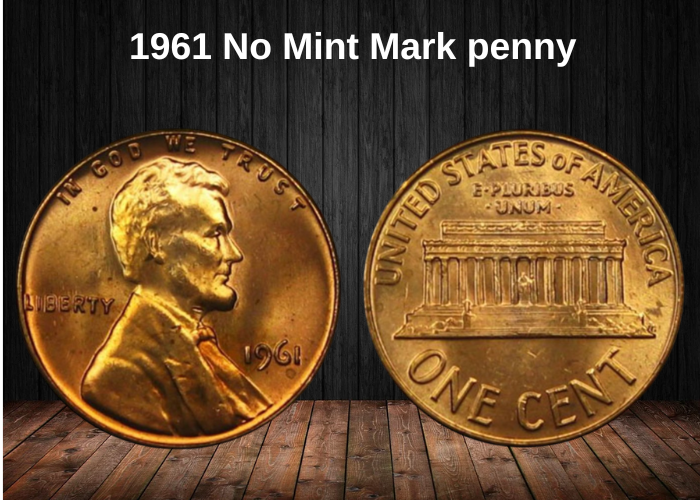
The Philadelphia Mint struck significantly fewer 1961 No Mint Mark pennies than the Denver facility, producing 753,345,000 coins. This lower mintage impacts their market value today, with red-colored examples typically valued between $2 and $16. Only coins graded MS67 fetch notably higher prices, with estimates around $750.
The most valuable example of this type sold for $5,720 at auction in 2013. While brown and red-brown variants exist, they usually hold little premium above face value. That said, a few have surfaced at auction with prices ranging from $100 to nearly $600.
1961 proof penny Value
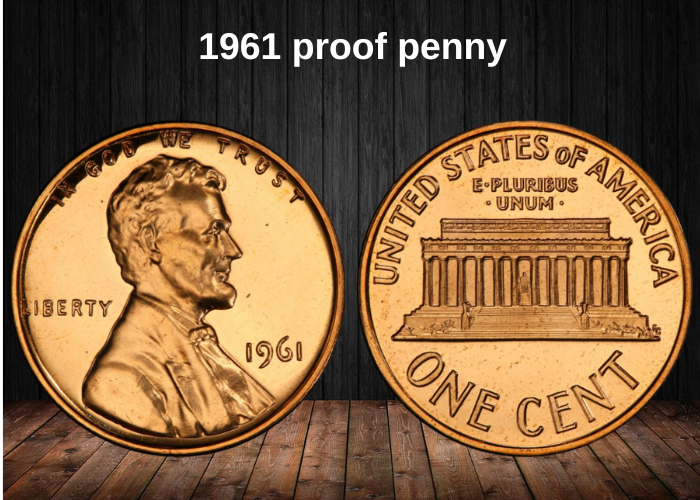
In 1961, the Philadelphia Mint produced 3,028,244 proof Lincoln pennies to meet collector demand. These coins can exhibit various tones depending on their condition and how well they’ve been preserved over time.
Basic red-colored proofs in grades PR60 to PR63 are generally worth only their face value. However, coins in higher grades—such as PR68—can reach values around $32, while top-quality examples graded PR69 may sell for approximately $150.
Red proofs with cameo contrast (CAM) range from $1 to $40, with PR69 examples valued at about $450. But deep cameo (DCAM) proofs are where values really begin to rise. Coins graded PR66 to PR67 typically cost between $50 and $100. Better-preserved specimens can be worth significantly more:
- PR68 DCAM: estimated at $600
- PR69 DCAM: valued at up to $6,000
Auction results have occasionally exceeded expectations. In 2006, a red PR65 proof sold for $1,265. A PR69 CAM example brought $1,035 in 2005, while the record-holder is a PR69 DCAM cent, which sold for $4,320 in 2018.
1961 D penny Value
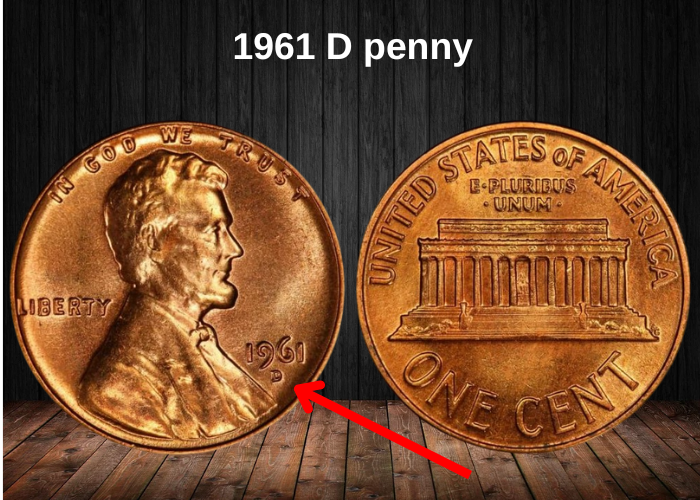
Due to the large mintage of 1,753,266,700 pennies, these coins remain relatively affordable regardless of their condition. Red examples are the most sought after by collectors, with prices ranging from $0.40 for an MS 60-graded coin to $24 for one in MS 66 condition.
Pennies with a rare MS 67 grade are valued around $650, although some have sold for much higher prices at auctions. For example, a well-preserved red penny from Denver was sold for $4,406 in 2014.
Rare 1961 Penny Errors List
As with most pennies, the 1961 Memorial cent series features various standard errors commonly found in this coin type. However, only rare coins with notable imperfections stand out, making them more collectible and potentially worth more than others.
Doubled die
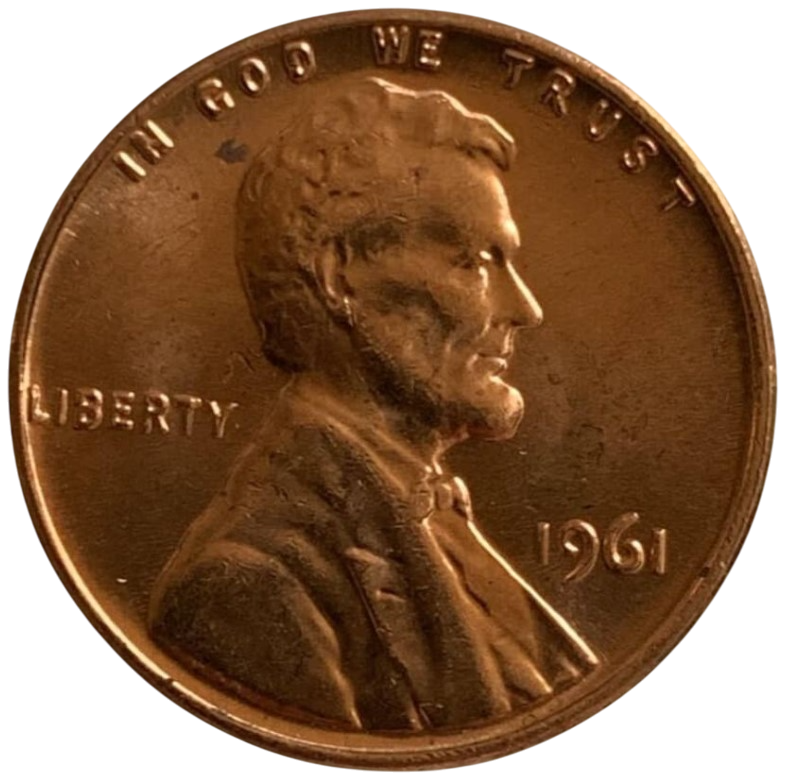
Doubled die error pennies are always in demand, and they tend to be more valuable than regular coins. However, the errors on the 1961 pennies are usually minor, often only visible under magnification.
So, don’t expect to find pieces worth hundreds of dollars, like in some other series. Your best bet would be to buy a coin with slight doubling on the lettering or date, which typically costs $5 to $20. Thanks to their affordable prices, these coins are a great option for beginner collectors and those on a budget.
Re-punched mint mark
Re-punched mint mark (RPM) errors are a result of the manual process used by workers at the Denver mint in 1961, as they didn’t have machines for punching mint marks. This method was discontinued in the early 1960s, but RPM errors can still be found on 1961 pennies.
There are three main types of RPM errors:
- Pennies with a sideways-struck mint mark with another one re-punched in the correct position.
- Pennies with a mint mark that was initially upside-down, then re-punched correctly.
- Pennies with two D’s – one in the wrong spot and the other in the right place.
Most of these error coins are fairly easy to find on the market for around $3 to $5. However, specific varieties, like the 1961 D/horiz D pennies, can be worth anywhere from $10 to $60. Only exceptionally rare and high-quality pieces, such as a red MS 65-graded coin, can bring higher prices, with one such coin selling for $228 in 2010.
Off-center
Off-center error coins are highly sought after by collectors, especially those with a 40% to 60% off-center error. The most desirable ones are those with more than 50% of the coin missing a design, creating a crescent-shaped blank space.
Serious collectors prefer coins with noticeable design and a visible date. For example, coins with a 50% off-center error can fetch around $100.
However, coins with minimal imperfections (around 1% to 3% off-center) generally have little to no value. On the other hand, 5% to 10% off-center 1961 pennies are more affordable, typically ranging between $5 to $15.
Where to sell your penny?
Now that you know the value of your penny, you might be wondering where to sell it. Don’t worry: here’s a guide to some of the best online platforms where you can easily sell your coins, along with their advantages and disadvantages.
Discover the best platforms for selling coins online (pros and cons).
FAQ about the 1961 Penny
1. Why is the 1961 Lincoln Penny historically significant?
The 1961 Lincoln Penny is part of the Lincoln Memorial reverse series, a design that was used on U.S. pennies from 1959 to 2008. While it doesn’t have a major error variety like some earlier pennies, it is important because it was struck during the years when the U.S. Mint was producing billions of coins to meet the demands of the growing economy. It represents a period of stability in U.S. coinage before the major changes of the 1980s.
2. What is the composition of the 1961 Lincoln Penny?
The 1961 Lincoln Penny is composed of:
- 95% copper
- 5% tin and zinc
It weighs 3.11 grams, which is consistent with all pennies made between 1909 and 1982 (except for the steel pennies of 1943). The penny has a diameter of 19.05 millimeters.
3. How many 1961 Lincoln Pennies were minted?
The total mintage of the 1961 Lincoln Penny is as follows:
- Philadelphia Mint (no mintmark): 1,043,591,000
- Denver Mint (D): 1,060,763,000
- The total combined mintage was about 2.1 billion coins, making it an extremely common coin.
4. What is the value of a 1961 Lincoln Penny today?
The value of a 1961 Lincoln Penny depends on its condition:
- Circulated coins: Generally worth 1 to 5 cents.
- Uncirculated coins (MS-63): Can range from $0.50 to $1.
- High-grade coins (MS-65 or higher): May be worth between $5 and $10, depending on the quality.
- Proof coins (only from Philadelphia): Worth around $3 to $8 depending on grade.
Since the 1961 penny has a high mintage and isn’t known for significant errors or varieties, its value remains relatively low unless in exceptional condition.
5. Are there any notable error varieties with the 1961 Lincoln Penny?
While the 1961 Lincoln Penny is not known for major varieties, collectors should still be on the lookout for minor mint errors. Some potential varieties and errors include:
- Die Cracks: These occur when a crack forms in the die, leaving a raised line on the coin.
- Off-Center Strikes: Misaligned strikes can sometimes make for more interesting examples, though they are rare.
- Double Die Obverse (DDO): Slight doubling on the inscription or Lincoln’s portrait, though not as common as in earlier years.
Overall, the 1961 penny is not as famous for error varieties as earlier years, but it can still attract attention for these minor flaws.
6. What is the most common condition for the 1961 Lincoln Penny?
Given the high mintage of the 1961 Lincoln Penny, most coins found today are in circulated condition. Common characteristics include:
- Worn details on Lincoln’s portrait and the wheat stalks.
- Light discoloration, often from exposure to air and handling.
- Moderate scratches or surface wear, especially on coins that have been in circulation for decades.
Coins in fine to very fine condition are more common, while those in uncirculated or gem quality are rarer and more valuable.
7. How can I tell if I have a high-grade 1961 Lincoln Penny?
To identify a high-grade 1961 Lincoln Penny, look for:
- Sharp detail: The date, Lincoln’s portrait, and the wheat stalks should be clearly defined, with little to no visible wear.
- Smooth surfaces: Coins with high grades (such as MS-65 or higher) should have very few contact marks, abrasions, or other imperfections.
- Luster: Uncirculated coins should exhibit a shiny, reflective luster and a clean appearance, free from toning or discoloration.
- Well-defined rims: Rims should be fully intact without any damage or heavy wear.
High-grade coins will show no signs of significant wear, and their surfaces will retain their original brilliance.


















































